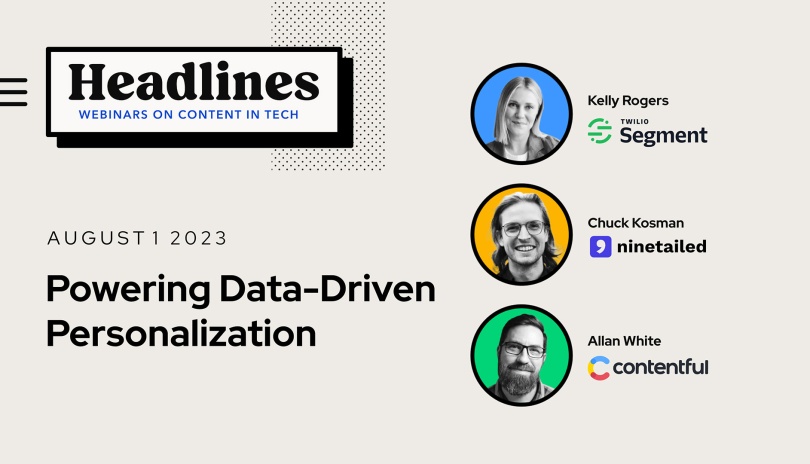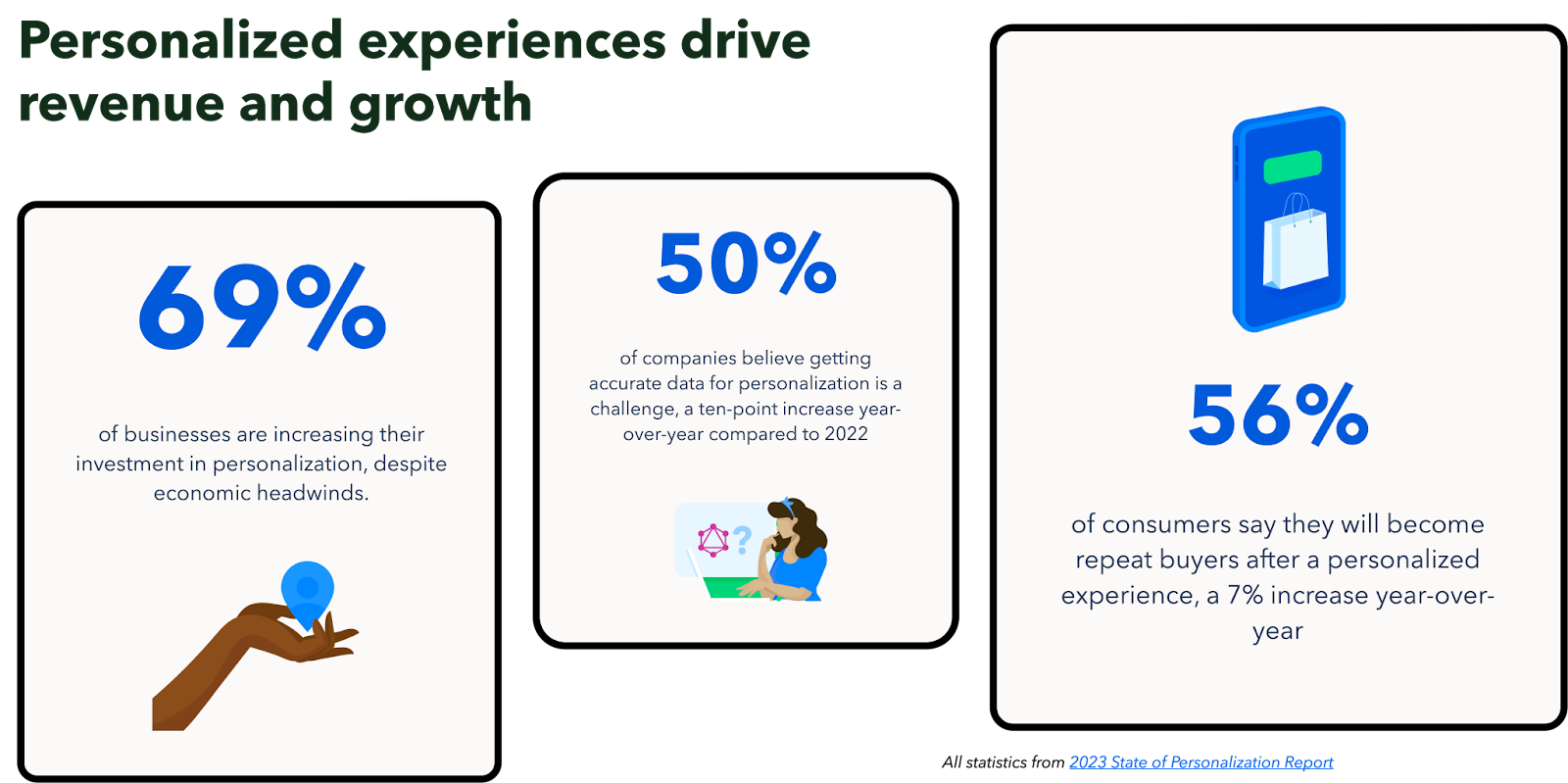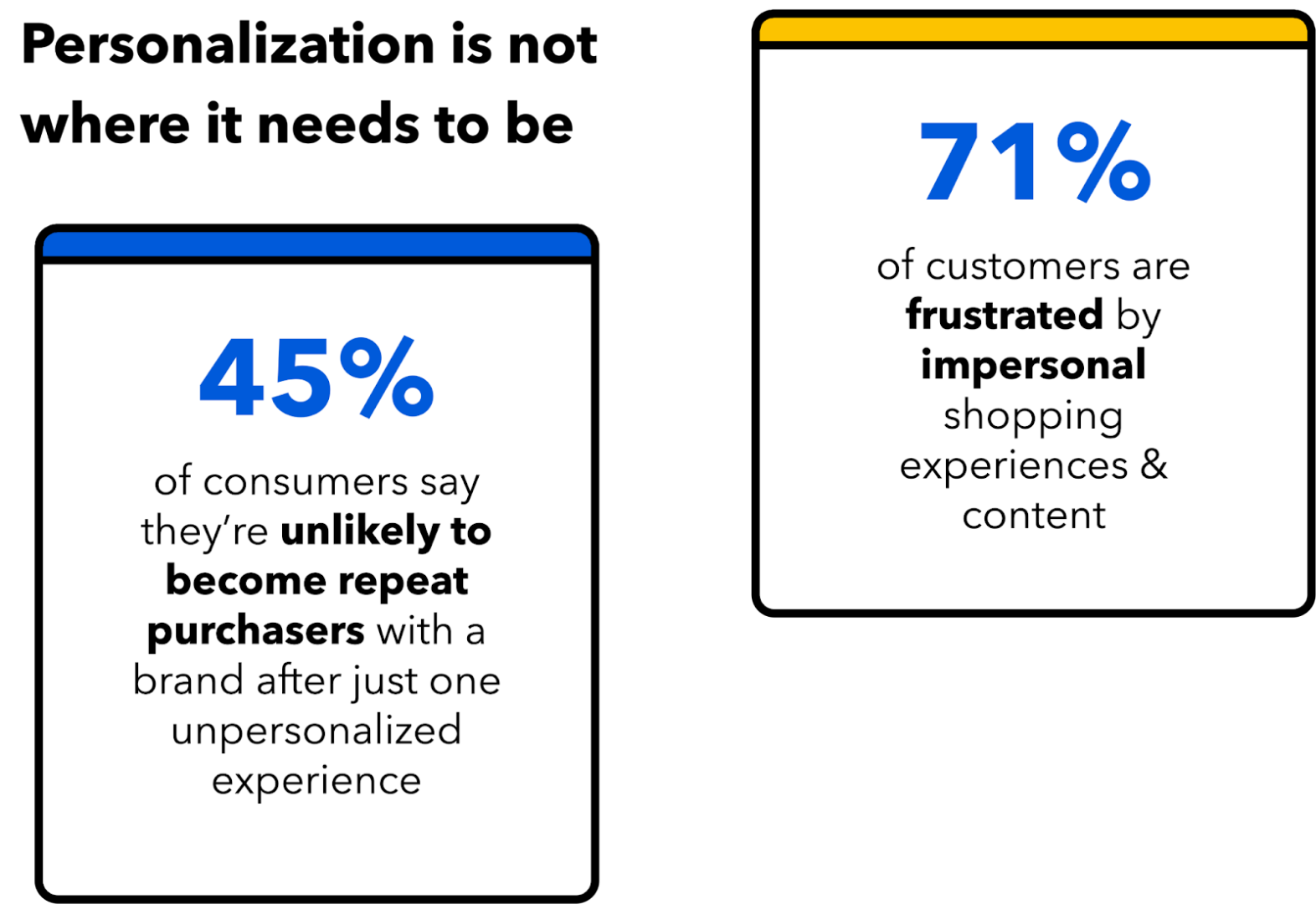Powering data-driven personalization with Contentful, Twilio Segment, and Ninetailed

Continuing our Headlines Webinars on Content in Tech series, we had another terrific opportunity to explore digital transformation and its effects on modern businesses. This series is designed to foster conversation among industry leaders, experts, and innovators.
We were delighted to be joined by two special guests, representing key technology partners: Kelly Rogers, a Principal Solutions Engineer at Twilio Segment, and Chuck Kosman, a Solutions Engineer from Ninetailed.
Twilio Segment is a customer data platform (CDP) dedicated to facilitating intelligent customer engagement across all channels. Ninetailed is an API-first personalization and experimentation engine that enhances experiences powered by content management systems. Both partners ensure easy configuration and high performance in composable solutions.

The current state of personalization in the market: Trends, challenges, and opportunities
Our discussion began with an overview of the current state of personalization in the market, drawing from Twilio Segment’s annual State of Personalization Report.
This report offers a detailed look into the latest trends in personalization, consumer loyalty, privacy, and more. It uses comprehensive survey analysis from business leaders and consumers to uncover the strategies businesses employ to forge deeper connections with their customers.
Despite the economic uncertainty that persists for many businesses, the report revealed that approximately 69% of surveyed businesses are increasing their investment in personalization. This trend suggests a recognition of the value of personalization in cultivating engaging and loyal customer relationships, even in challenging times.
Correspondingly, from the consumer’s perspective, the increase in personalization investment is justified. Around 56% of customers say they’re more likely to become repeat buyers after a personalized experience — a figure that’s risen by about 7% year-on-year from this report.

The challenge of fragmented data
However, the picture isn’t entirely rosy. While businesses understand the importance of personalization and consumers respond positively to personalized experiences, many companies struggle with data management. The challenge lies in consolidating data from various teams into one cohesive place to fuel personalized experiences.
Have you ever experienced seeing an advertisement that was completely unrelated to you? You might wonder how you ended up in that targeting pool. Or perhaps you’ve visited a website to find a product you’ve purchased before, but instead of having it surface immediately, you had to do some digging. This frustrating and impersonal experience is a sentiment shared by 71% of consumers.
Both companies and customers desire personalized experiences, but delivering it is challenging. Approximately 45% of consumers say they’re unlikely to become repeat purchasers with a brand after just one generic, unpersonalized experience. This signals a clear need for businesses to improve their personalization efforts.

Why is this so challenging to deliver on? Fragmented data is one common culprit. Many companies struggle with managing their data, often resulting in disconnected data silos. Your customer data lives within different parts of your company — email, web, social, analytics — and bringing it into one cohesive place is a challenge. This leads to an incomplete view of the customer, with pieces of inconsistent data scattered across multiple places. The result is a disjointed customer experience and journey.
In an attempt to solve this, companies often create haphazard patchwork solutions to connect their data silos and customer experiences. These approaches add technical debt, additional work, and rarely address the heart of the data problem.
A CDP like Twilio Segment automates the process of collecting, cleaning, and synthesizing data. By ensuring that data is clean, complete, and consistent, a CDP empowers marketers and other stakeholders in your company to make informed business decisions.
The issue of fragmented data also resonates with Contentful. We aim to help businesses compose, structure, and reuse content to create efficiencies. However, as Contentful is open-ended and not prescriptive, businesses must sometimes invest extra efforts in creating and managing additional content models for marketing operations, site operations, and ecommerce. While necessary, this can be conceptually challenging and adds some complexity.
Adopting a customer data platform for improved marketing personalization
The discussion then moved to the power of a CDP, like Twilio Segment, in providing marketers with tools to better understand and leverage their data. Often, marketers may not fully understand all the potential “levers” they can pull when creating audiences. Can they incorporate all email opens, for instance, or all product views and clicks, into an audience for personalized content?
A CDP comes equipped with out-of-the-box tools that allow for a consistent data schema, clarifying those exact naming conventions to work with in systems like Ninetailed or Contentful. This consistency proves invaluable when running reports, ensuring everyone is talking about the same thing. For instance, “add to cart,” “cart added,” and “products added” might all refer to the same action, but having a consistent naming structure eliminates confusion.
Twilio Segment, serving as the front door for data, handles a staggering trillion customer data points every year. It assesses this data to ensure it matches expected events. If an event comes in that’s not named correctly or is unexpected, Twilio Segment can flag this to prevent “dirty” or incomplete data from entering Contentful (or where it would be used to create personalized experiences).
One of the most exciting moments, Kelly explains, is when all this data comes together in analytics. Seeing different cohorts and audiences behaving in certain ways, thanks to Twilio Segment connecting behaviors and personalization, is a sight to behold. This process is becoming increasingly real today and can potentially move those ones and twos in the personalization poll higher up, indicating an improved level of personalization.
Unlocking the power of personalization for enhanced customer experiences
Every business aims to personalize experiences to boost acquisition, loyalty, and lifetime value. However, intelligent businesses understand that real-time identity resolution and complete, trusted customer profiles form the cornerstone of effective personalization. Successful businesses can create incredible personalized customer experiences across channels because they have a reliable set of customer profiles to operationalize across their businesses.
These customer profiles within Twilio Segment can be synchronized with your data cloud and combined with other data sets, allowing you to build what we like to call the “golden customer profile.” This profile can be used to create outstanding personalized experiences.

Twilio Segment Connections. Kelly showed us how to connect Contentful content and Ninetailed events in the demo.
However, achieving this requires effective identity resolution, which is often more challenging than expected. Stitching together a customer’s various activities, such as logging into an app, visiting a website, or adding something to a cart, is a complex task that often requires significant engineering effort.
As Kelly explains, Twilio Segment offers to do this heavy lifting for you.
“We take in all the different first-party identifiers across all your customer touchpoints, bring them into Twilio Segment, and use our out-of-the-box identity graph to stitch together these identifiers. This process enables us to build a 360-degree view of your customer, helping break down data silos and provide a comprehensive view of their entire customer journey.”
Furthermore, this process is fundamentally omnichannel. It’s not limited to just one channel but spans across multiple ones, including in-store data.
“We pride ourselves on our deterministic methodology in identity resolution, ensuring you can have 100% confidence in the accuracy of the data as you build out personalized experiences for your customers,” Kelly says. “This flexibility of bringing in different identifiers ensures that you’re capturing customers wherever they might be.”
The concept of a golden profile is one that many businesses strive for, as it allows them a comprehensive understanding of their customers. However, connecting all this customer data with personalization challenges in Contentful involves many moving parts.
Contentful operationalizes content, providing everything that content authors need. Twilio Segment, on the other hand, offers the mechanisms by which identities across different sources are unified. Ninetailed brings personalization and experimentation directly into the content management system itself, effectively bridging these two specialized, omnichannel solutions.
“Often, businesses want to know how they can use their existing customer data within Contentful,” Chuck says. “Essentially, they’re asking how they can activate their existing knowledge about customers or information acquired through different customer journeys across various sources that Twilio Segment can operate. This is where Ninetailed steps in.”
Ninetailed acts as a destination for Twilio Segment, storing a profile representation of a user and extending to a content model as well as the interface of the content management system. This enables authors to work with all the rich information that Twilio gathers about different identities across multiple touchpoints, activating it as content within Contentful. This process allows businesses to drive compelling experiences based on their understanding of their customers.

Ninetailed effectively bridges the gap between upstream sources like Twilio Segment and the content management system, Contentful.
According to Chuck, “If you’ve experienced frustration due to disjointed data or had to navigate different interfaces to author experiments and personalizations, Ninetailed offers a more seamless solution.”
Ninetailed extends Contentful, allowing you to author personalizations and experiences within the same platform. This means all your personalizations can leverage Contentful’s capabilities. If you’re accustomed to using preview modes in Contentful, you can use them to deploy personalizations predictably. If you need custom roles and permissions to control who can publish or review personalizations, Contentful’s system allows for that. And if you’re interested in Contentful’s live preview feature, Ninetailed integrates well with that too.
“The integration of Ninetailed with Contentful is so smooth that personalization variants simply work within the Contentful interface,” Chuck explains. “This is because Ninetailed’s personalization and experimentation content is just Contentful content. There’s no need to wrangle another data source, and you can fully leverage Contentful’s optimized content delivery. This makes it easier to create and manage personalized experiences, thereby achieving the ‘golden profile’ for your customers.”
An excellent example of the benefits of combining our platforms comes from the major ecommerce brand, Ruggable. They use Shopify for their ecommerce platform and Contentful for their content management system. Instead of providing a generic experience for every visitor, Ruggable implemented a more personalized approach, which resulted in a 25% increase in their conversion rate and a nearly seven-fold increase in click-through rates on their hero images.
For instance, if a visitor clicked on an ad targeting pet owners, they would be greeted with a specific hero image of a dog making a mess on a rug — a scenario familiar to many pet owners. This personalized content significantly enhanced user engagement.
Moreover, because all this personalized content lived within the CMS, their engineers could retrieve and serve it predictably. As a result, their campaign creation time decreased from days to just hours or even minutes in some cases.
This shift toward more modular, personalized content — swapping out banners, calls to action, promos, or heroes based on audience — is a trend we’re observing across the board. It not only makes it easier for content teams but also allows for building richer, more personalized permutations of any given page. Instead of creating a separate homepage for every use case, you can have different banners and heroes for various use cases, making the sum of the personalized experience greater than its parts.
Maximizing cross-channel personalization
To truly understand the power of integrating Twilio Segment, Ninetailed, and Contentful, consider these three key benefits:
First, you achieve consistent cross-channel content. Twilio Segment captures data points from all your different channels (email, website, mobile app, etc.). If a user opens an email, for example, Twilio Segment can send data about that action to Ninetailed and Contentful, ensuring similar content is shown on the web for a consistent user experience.
Second, it enables profile enrichment for personalization. Twilio Segment captures a wealth of data from your customer data platform, allowing you to infer new information about your customers based on their behavior. For instance, if a user frequently views a certain category of product, Twilio Segment can infer that this is their preferred category, enabling Ninetailed and Contentful to showcase related content.
Third, it enables omnichannel journey personalization. You might want to show certain content only if a previous action has been taken. Twilio Segment provides an out-of-the-box journey builder to funnel users into a journey based on specific actions, allowing Ninetailed and Contentful to render personalized content accordingly.
These benefits all hinge on having a comprehensive view of your customer (the golden profile) and operating off clean, consistent data. Additionally, Ninetailed can integrate with existing analytics systems or use its own experience statistics product to report on the success of personalizations and experiments, further enhancing the user experience.
Wrapping up
This insightful discussion has highlighted how companies and software solutions are making personalization and customer data tangible, which is a critical aspect of modern digital experiences.
Our event series, “Headlines,” presents a platform for experts in the field to share their experiences and insights. The focus is on showcasing forward-thinking brands and collaborative partners like Twilio Segment and Ninetailed who leverage Contentful to surmount technical challenges and scale complex digital experiences — all while empowering their teams to manage and control these systems efficiently.



